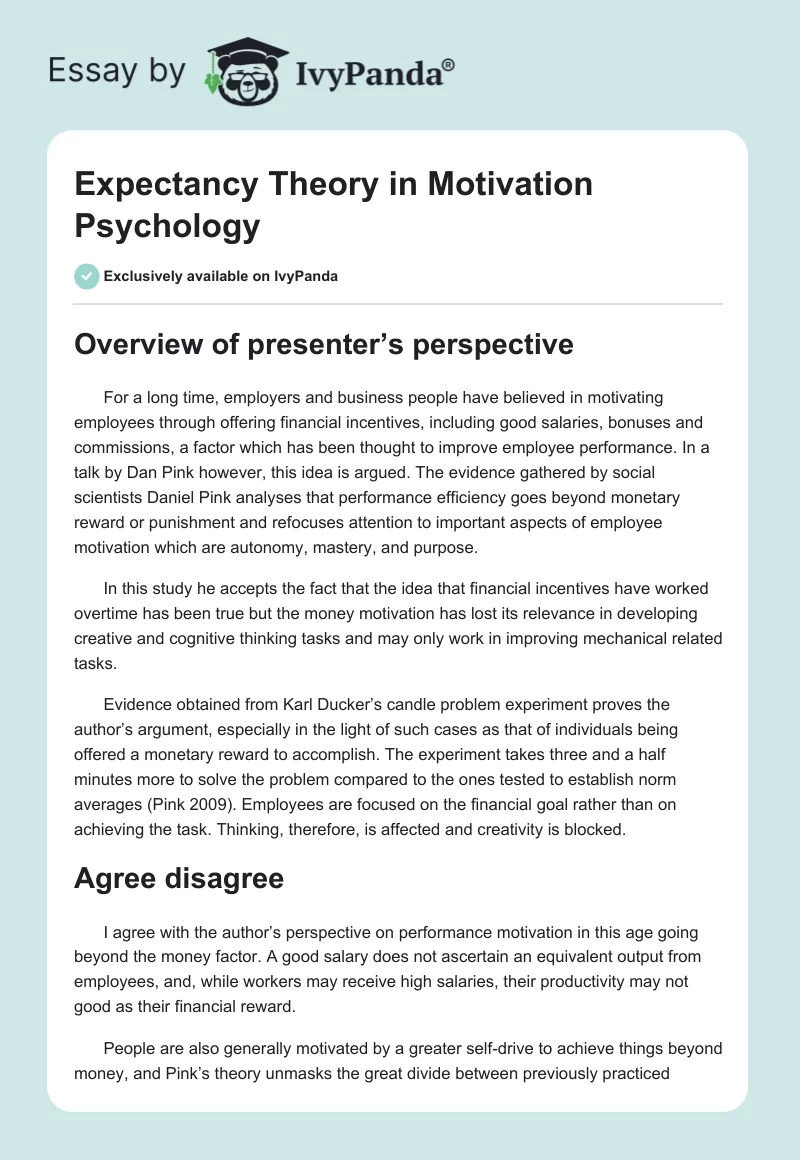Overview of presenter’s perspective
For a long time, employers and business people have believed in motivating employees through offering financial incentives, including good salaries, bonuses and commissions, a factor which has been thought to improve employee performance. In a talk by Dan Pink however, this idea is argued. The evidence gathered by social scientists Daniel Pink analyses that performance efficiency goes beyond monetary reward or punishment and refocuses attention to important aspects of employee motivation which are autonomy, mastery, and purpose.
In this study he accepts the fact that the idea that financial incentives have worked overtime has been true but the money motivation has lost its relevance in developing creative and cognitive thinking tasks and may only work in improving mechanical related tasks.
Evidence obtained from Karl Ducker’s candle problem experiment proves the author’s argument, especially in the light of such cases as that of individuals being offered a monetary reward to accomplish. The experiment takes three and a half minutes more to solve the problem compared to the ones tested to establish norm averages (Pink 2009). Employees are focused on the financial goal rather than on achieving the task. Thinking, therefore, is affected and creativity is blocked.
Agree disagree
I agree with the author’s perspective on performance motivation in this age going beyond the money factor. A good salary does not ascertain an equivalent output from employees, and, while workers may receive high salaries, their productivity may not good as their financial reward.
People are also generally motivated by a greater self-drive to achieve things beyond money, and Pink’s theory unmasks the great divide between previously practiced human capital practices that businesses have employed overtime in comparison to what really works. From the study, one realizes that greater persistence is required to accomplish difficult tasks, which cannot be equated to money rewards. Great achievements in life have been driven by passion and determination that surmounts the money factor.
While a reward and punishment approach related to “carrot and sticks’ in Pinks analysis is an effective tool to make work happen in many cases it only makes a part of the bigger picture. This factor helps one achieve goals on a short-term perspective before it loses its significance. Getting rid of the money problem is a key factor in ensuring performance is achieved but certainly not the most basic.
Theory Backing: Vroom’s Theory
The idea of improving people’s performance by providing them with incentives, moral support and encouragement has a sufficient theoretical support to be viewed as a reliable strategy for an organization’s performance improvement. Indeed, considering the case closer, one must admit that the concept of motivation and encouragement complies with the key postulates of Vroom’s theory.
According to the theory suggested by Vroom, which would later on be called the Expectancy Theory, the behavior of a person is largely predetermined by the consequences that their behavior is going to have. In other words, a person can be encouraged for doing something once a reward for the action in question is introduced, or convinced not to undertake a certain action or set of actions if there is a punishment for that.
The theory was created by Victor H. Vroom, as it has been stressed above; the discovery that would later on reinvent the entire concept of motivation both in work and studying was developed in 1960s and has been explored in depth since then (Lunenburg, 2011). One may argue that not all the elements of the Expectancy Theory align with the details presented in the case in point. True, such an important part of Vroom’s theory as punishment seems to have been removed nearly completely from the framework in the case study under consideration.
Such a radical change to the Expectancy Theory might be viewed as rather dangerous and quite unnecessary. However, recent researches show that the need for recognition and acclaim and the corresponding job satisfaction are as important to the productive performance of an individual as criticism is; in fact, approval may turn out of an even greater effect. Therefore, slightly modified, the Expectancy Theory can be considered the foundation for the strategy for motivation increase.
Relevance for real world application
At present, large companies prefer providing their staff with emotional support and non-financial approval rather than giving their staff monetary rewards. I think that this is an appropriate strategy and a welcome change of pace. Studies show that financial rewards create short-term leaps but are damaging in the end. Non-financial incentives, on the contrary, serve as the means to establish a stronger bond between the staff and the managers.
Good work environments that grow employee talents work well in motivating employee performance. Enabling employees grow their individual professional skills also works to the advantage of any firm as concerning performance. Other factors like praise from immediate supervisors and managers motivate employees who normally want for leadership attention and recognition within their offices. Recognition may be achieved through titles like employee of the year awards. Employees also gain drive from being awarded major tasks which makes them feel appreciated and believed in which gives them drive to put in more, a factor which may not be achieved by bonus incentives.
Reference List
Lunenburg, P. C. (2011). Expectancy Theory of Motivation: Motivating by altering expectations. International Journal of Management Business and Administration, 15(1), 1–6. Web.


